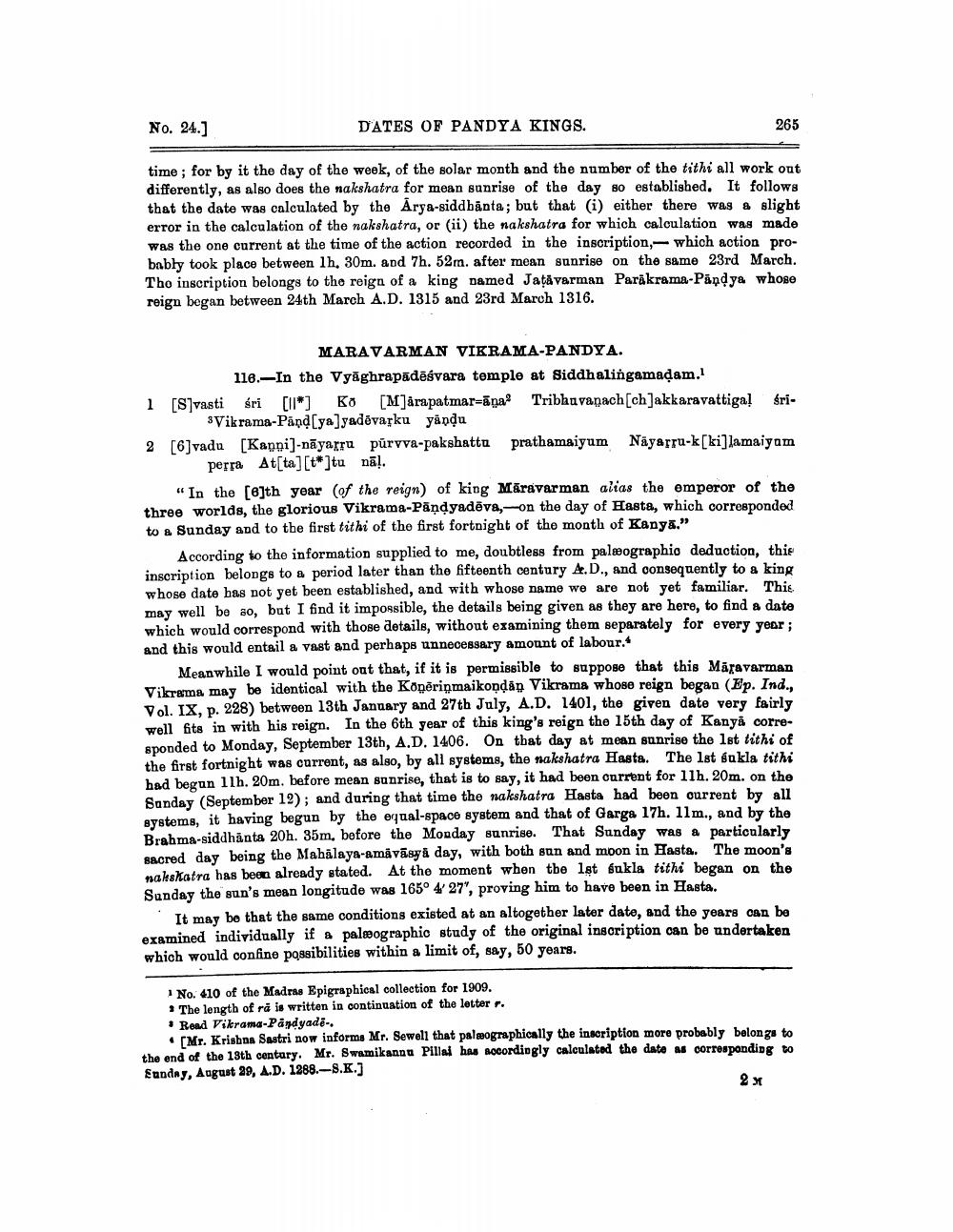________________
No. 24.]
time; for by it the day of the week, of the solar month and the number of the tithi all work out differently, as also does the nakshatra for mean sunrise of the day so established. It follows that the date was calculated by the Arya-siddhanta; but that (i) either there was a slight error in the calculation of the nakshatra, or (ii) the nakshatra for which calculation was made was the one current at the time of the action recorded in the inscription, which action probably took place between 1h, 30m. and 7h. 52m. after mean sunrise on the same 23rd March. Tho inscription belongs to the reign of a king named Jaṭavarman Parakrama-Pandya whose reign began between 24th March A.D. 1315 and 23rd March 1316.
MARAVARMAN VIKRAMA-PANDYA.
116. In the Vyaghrapādēsvara temple at Siddhalingamaḍam.1
1 [S]vasti śri [*]
DATES OF PANDYA KINGS.
Ko
[M]Arapatmar-pa
Vikrama-Phod[a]yadavarku yaodu
Tribhavanach[ch]akkaravattigal
265
2 [6]vada [Kanoi)-nkyarra parvva-pakshatta prathamaiyum Nayarru-k[ki]lamalyam perra At[ta][t]tu nal.
"In the [6]th year (of the reign) of king Maravarman alias the emperor of the three worlds, the glorious Vikrama-Paṇḍyadēva, on the day of Hasta, which corresponded to a Sunday and to the first tithi of the first fortnight of the month of Kanya."
According to the information supplied to me, doubtless from paleographic deduction, this inscription belongs to a period later than the fifteenth century A.D., and consequently to a king whose date has not yet been established, and with whose name we are not yet familiar. This may well be so, but I find it impossible, the details being given as they are here, to find a date which would correspond with those details, without examining them separately for every year; and this would entail a vast and perhaps unnecessary amount of labour.
Meanwhile I would point out that, if it is permissible to suppose that this Maravarman Vikrama may be identical with the Kōnēriņmaikoṇḍan Vikrama whose reign began (Ep. Ind., Vol. IX, p. 228) between 13th January and 27th July, A.D. 1401, the given date very fairly well fits in with his reign. In the 6th year of this king's reign the 15th day of Kanya corresponded to Monday, September 13th, A.D. 1406. On that day at mean sunrise the 1st tithi of the first fortnight was current, as also, by all systems, the nakshatra Hasta. The 1st sukla tithi had begun 11h. 20m. before mean sunrise, that is to say, it had been current for 11h. 20m. on the Sunday (September 12); and during that time the nakshatra Hasta had been current by all systems, it having begun by the equal-space system and that of Garga 17h. 11m., and by the Brahma-siddhanta 20h. 35m, before the Monday sunrise. That Sunday was a particularly sacred day being the Mahalaya-amavasya day, with both sun and moon in Hasta. The moon's nakshatra has been already stated. At the moment when the 1st sukla tithi began on the Sunday the sun's mean longitude was 165° 4' 27", proving him to have been in Hasta.
1
No. 410 of the Madras Epigraphical collection for 1909.
The length of ra is written in continuation of the letter r.
It may be that the same conditions existed at an altogether later date, and the years can be examined individually if a paleographic study of the original inscription can be undertaken which would confine possibilities within a limit of, say, 50 years.
Read Vikrama-Pandyade-.
[Mr. Krishna Sastri now informs Mr. Sewell that paleographically the inscription more probably belongs to the end of the 18th century. Mr. Swamikannu Pillai has accordingly calculated the date as corresponding to Sunday, August 29, A.D. 1288.-S.K.]
2 x




